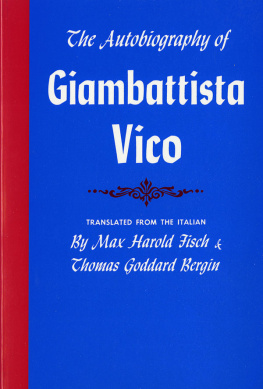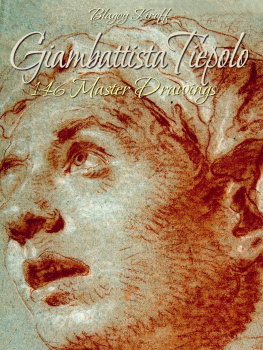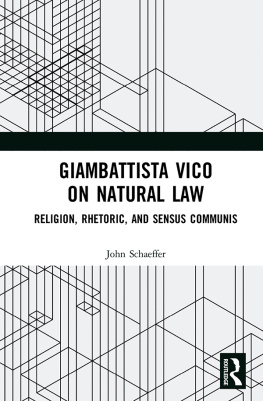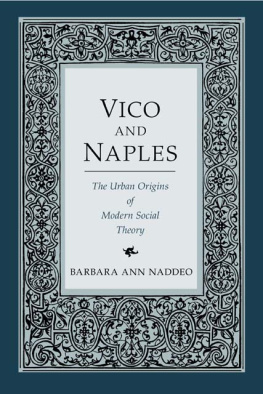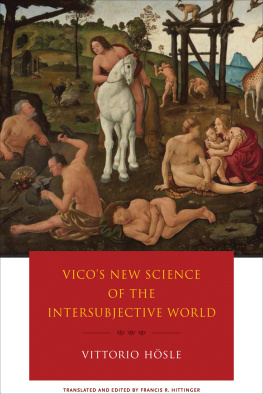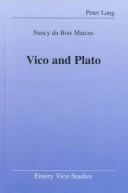Giambattista Vico - The New Science
Here you can read online Giambattista Vico - The New Science full text of the book (entire story) in english for free. Download pdf and epub, get meaning, cover and reviews about this ebook. year: 2020, publisher: Yale University Press, genre: Religion. Description of the work, (preface) as well as reviews are available. Best literature library LitArk.com created for fans of good reading and offers a wide selection of genres:
Romance novel
Science fiction
Adventure
Detective
Science
History
Home and family
Prose
Art
Politics
Computer
Non-fiction
Religion
Business
Children
Humor
Choose a favorite category and find really read worthwhile books. Enjoy immersion in the world of imagination, feel the emotions of the characters or learn something new for yourself, make an fascinating discovery.

- Book:The New Science
- Author:
- Publisher:Yale University Press
- Genre:
- Year:2020
- Rating:5 / 5
- Favourites:Add to favourites
- Your mark:
- 100
- 1
- 2
- 3
- 4
- 5
The New Science: summary, description and annotation
We offer to read an annotation, description, summary or preface (depends on what the author of the book "The New Science" wrote himself). If you haven't found the necessary information about the book — write in the comments, we will try to find it.
The New Science — read online for free the complete book (whole text) full work
Below is the text of the book, divided by pages. System saving the place of the last page read, allows you to conveniently read the book "The New Science" online for free, without having to search again every time where you left off. Put a bookmark, and you can go to the page where you finished reading at any time.
Font size:
Interval:
Bookmark:
The New Science
The New Science
Giambattista Vico
Translated and Edited by Jason Taylor and Robert Miner with an Introduction by Giuseppe Mazzotta
Yale UNIVERSITY PRESS
New Haven and London
Published with assistance from the Annie Burr Lewis Fund.
Copyright 2020 by Yale University.
All rights reserved.
This book may not be reproduced, in whole or in part, including illustrations, in any form (beyond that copying permitted by Sections 107 and 108 of the U.S. Copyright Law and except by reviewers for the public press), without written permission from the publishers.
Yale University Press books may be purchased in quantity for educational, business, or promotional use. For information, please e-mail (U.K. office).
Designed by Angie Sheltz, Newgen.
Set in Times New Roman MT type by Newgen North America.
Printed in the United States of America.
Library of Congress Control Number: 2019940873
ISBN 978-0-300-19113-4 (paperback : alk. paper)
A catalogue record for this book is available from the British Library.
This paper meets the requirements of ANSI/NISO Z39.48-1992 (Permanence of Paper).
10 9 8 7 6 5 4 3 2 1
Contents
Editors Preface
If I have seen further, it is by standing on the shoulders of giants, said Isaac Newton, whom Vico praises in The New Science as one of the two foremost geniuses of our age. This translation aims to become the standard English-language edition of Vicos magnum opus. But should it attain this goal, it will do so only because the translators have stood on the shoulders of scholarly giants. All Anglophone readers of Vico owe a large debt to Thomas Goddard Bergin and Max Harold Fischs translation, The New Science of Giambattista Vico, first published in 1948 by Cornell University Press. We have also benefited from the recent translation of David Marsh, published by Penguin in 1999. Why is another edition of Vico in English necessary?
Any translation is a compromise between literalness and readability, aiming at the elusive goal of fidelity. Where Bergin and Fisch tend toward literalness, Marsh opts for superior readability and often achieves it. He does so, however, at the price of fracturing the unity of the texts distinctive vocabularyas, for example, by using six different English words to render the key term ingegno. It may seem, then, that readers should stick with the older translation, owing to its reliability and readability, as Donald Verene puts it.
Despite its genuine merits, the Bergin and Fisch edition is marred by some defects. These suffice to warrant a new translation. In lieu of a tedious comprehensive listing, here is a small sample:
1. Omissions and mistakes. At the end of Book Twos section on Poetic Logic, Vico asserts that many things in human life were discovered in Greece prior to the arrival of the philosophersand adds that the grounds of his assertion will not be made visible until Book 3, when we reason upon the age of Homer. In their translation of 498, Bergin and Fisch omit this passage entirely, and thus obscure a link between Books Two and Three that Vico considers important. Near the end of the Book on Homer, Bergin and Fisch have Vico claim twice that the philosophers have written obscurely and confusedly about dramatic and lyric poetry. The charge, however, is clearly leveled at i filologi, the philologists (905).
2. Misleading literalism. Bergin and Fisch render favoloso by fabulous; their text speaks throughout of fabulous beginnings and fabulous history. Given the connotations of fabulous in contemporary English, this translation is inevitably misleading. Mythical beginnings and mythical history are closer to the sense Vico intends; mythical is more faithful, if less literal. In a similar vein, Bergin and Fischs text speaks of vulgar lettersa translation that tends to evoke images of salacious correspondence. There is nothing vulgar in our sense of the term about letteri volgari. (The present text adopts common alphabetic letters.)
3. Simple inconsistencies in key terms. Often sapienza riposta is esoteric wisdom; sometimes it appears as hidden wisdom or recondite wisdom. Virt is frequently virtue, but it becomes valor at 261, though Vico uses the Italian valor shortly thereafter at 277. Guisa is variously manner, process, form, case, way, and fashion.
Beyond repairing the faults of previous editions, the present translation aims to capture an important feature of Vicos style, well described by Giuseppe Mazzotta:
The prose of The New Science is ceaselessly marked by digressions that slow down the rhythm of the narrative, by quick forward thrusts of the discourse through dazzling intuitions, by repetitions and sinuous falling back on formulas previously stated but which are now re-viewed from a new angle. This convoluted narrative technique is occasionally cumbersome but necessary. It conveys Vicos sense of the complications within the order of causality. The positive links between cause and effect never function by a linear mechanism in this poetic-philosophical universe (The New Map of the World, p. 141).
In the interest of remaining faithful to his narrative technique, we have generally refrained from breaking Vicos longer sentences into a succession of short, choppy sentences. And when his style moves from seemingly unending chains of parataxis to Ciceronian periods, we attempt to carry this over into the translation as well. We have also preserved Vicos own system of paragraphing, attested by the handwritten copy and preserved in the edition published in 1744 by Stamperia Muziana. Accordingly, the present text indents only where Vico indentsthough it does use line spacing to give the modern reader necessary relief from large grey blocks of text. Because scholars have long been accustomed to cite The New Science by the paragraph numbers that originate in the Italian edition of Fausto Nicolini and that later editions and translations reproduce, these numbers appear in the margin of the text.
The present edition contains significantly more annotations than previous translations. Vicos erudition is breathtaking, and the intellectual terrain in which he situates himself is complex. Our aim is to enhance the readers awareness of the many voices with which he is in dialogue. Some of these voices are named explicitly. Many others are evoked by implicit allusions to texts, ancient and modern. Though by no means exhaustive, our annotations will give the Anglophone reader more help than she has had so far.
A distinctive feature of this edition is its reproduction of a range of attributes that appear on the surface of the text printed in 1744. These are attributes that remain invisible to the reader of modern editions, whether in English or Italian. They include the following:
1. The practice of quoting passages from classical texts in Latin. Vico frequently indents these passages, separating them from the main text in a manner that interrupts it, breaking its flow. The effect is to give the quotations a prominence that is lost when they are merged seamlessly into the main text. Our text reproduces the Latin, followed by a parenthetical translation.
2. Using the Greek alphabet to reproduce Greek words and phrases. Though Vicos Greek was inferior to his Latin, he judged it vital to present Greek terms in the original language. He rejected the option of transliterating them into the Roman alphabet.
3. Preserving the emphasis on words designating components within Vicos system, particularly Corollary and (to a lesser extent) Proof. By respecting the 1744 editions typographywhich closely tracks the handwritten manuscriptour edition gives the reader a more vivid perception of Vicos desire to present the new science as a system, complete with axioms, postulates, demonstrations, and corollaries.
Next pageFont size:
Interval:
Bookmark:
Similar books «The New Science»
Look at similar books to The New Science. We have selected literature similar in name and meaning in the hope of providing readers with more options to find new, interesting, not yet read works.
Discussion, reviews of the book The New Science and just readers' own opinions. Leave your comments, write what you think about the work, its meaning or the main characters. Specify what exactly you liked and what you didn't like, and why you think so.

